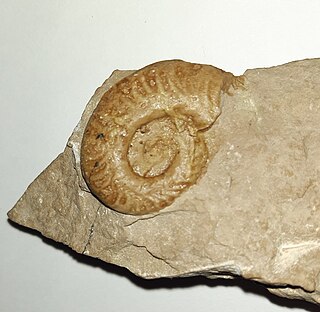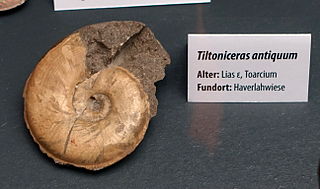
Hildoceras is a genus of ammonite from the Jurassic period in the family Hildoceratidae. The shells are characterized by a narrow discoidal evolute shape, keeled venter, concave ribs along the outer flanks, and a shallow spiral groove running along smooth inner flanks. Whorls slightly overlap, cross sections are compressed. The ventral keel is bordered on either side by a shallow groove. The genus was named by Alpheus Hyatt after Saint Hilda in 1876.
Suevoleviathan is an extinct genus of primitive ichthyosaur found in the Early Jurassic (Toarcian) of Holzmaden, Germany.

Lobolytoceras is an extinct genus of ammonite in which only the inner whorls have large swollen ribs, later whorls have wrinkled growth lines which coarsen somewhat, near the aperture. The genus is known from the Lower Jurassic Toarcian of Europe. The type species L. siemensi (Denck) came from the Upper Toarcian of Germany.

Harpoceras is an extinct genus of cephalopod belonging to the family Hildoceratidae. These cephalopods existed in the Jurassic period, during Toarcian age from Falciferum zone to Commune subzone of Bifrons zone. They were fast-moving nektonic carnivores.

Harpoceratinae is an extinct subfamily of cephalopods belonging to the family Hildoceratidae. Ammonites of this subfamily had involute and compressed shells with strong keels. Keel might be rarely missing, but this is considered to be an abnormality. This has been observed both in Cleviceras and Harpoceras and called as genus Monestieria, which is now known to be invalid. Another example is Pseudolioceras, whose unkeeled specimen was used as type for description of invalid genus Praehaploceras. Oxyconic forms of this subfamily does not have any keel. Ribs were single, but in some genera also bifurcating with shapes from sigmoidal to falcate. Sometimes, shell can have only striate ribs or is smooth. Tubercules are rare. Dimorphism is known in some genera and it is observable mostly in size. Macrochons can be 4, to 6 times larger than microconchs. As an example, macroconchs of Pseudolioceras are more than 150mm in diameter, while adult microconchs are only 35-50mm. There are big size differences even within dimorphs. Specimens ca be 2, or sometimes even 3 times bigger than other specimens of same dimorph.

Cleviceras is an extinct genus of cephalopod belonging to the family Hildoceratidae. These cephalopods existed in the Jurassic period, during Toarcian and possibly even uppermost Pliensbachian age. Sometimes, it is considered to be a synonym of Eleganticeras.

Prodactylioceras is genus of ammonite that lived during the Pliensbachian stage of early Jurassic. It has evolved from Reynesocoeloceras, but maybe not directly, but through Bettoniceras. Its fossils were found in Europe, Asia and North America.
Peronoceras is genus of ammonite that lived during the middle Toarcian stage of early Jurassic. Members of this genus existed only in Fibulatum Subzone of Bifrons Zone. Their fossils were found in Europe, northern Africa, Asia, North America and South America.
Porpoceras is genus of ammonite that lived during the early and middle Toarcian stage of early Jurassic. Members of this genus existed from uppermost part of the Harpoceras serpentinum zone to the Haugia variabilis zone. Their fossils were found in Europe, Asia, North America and South America.
Reynesoceras is genus of ammonites that lived during the upper Pliensbachian stage of early Jurassic. It has evolved from Prodactylioceras, or Cetonoceras. Dactylioceras (Eodactylites) has probably evolved from this genus. Aveyroniceras is a name for macroconchs of this genus. Their fossils were found in Europe, northern Africa, Asia, North America and South America.
Septimaniceras is genus of ammonites that has probably evolved from Peronoceras and lived during the middle Toarcian stage of early Jurassic. Members of this genus existed from Bifrons Subzone to lower part of Variabilis Subzone. Their fossils were found in France, Hungary and probably also in Austria.
Catacoeloceras is genus of ammonite that lived during middle to late Toarcian stage of early Jurassic. Members of this genus existed from Crassum Subzone of Bifrons Zone to Variabilis Zone. Their fossils were found in Europe, northern Africa, Asia, North America and South America. It has evolved from Peronoceras, or Porpoceras.
Nodicoeloceras is genus of ammonite that lived during early to middle Toarcian stage of early Jurassic. Members of this genus existed from Exaratum Subzone of Falciferum Zone to Commune subzone of Bifrons Zone. Their fossils were found in Europe, northern Africa, Asia, North America and South America. It has probably evolved from Dactylioceras (Orthodactylites) or Kedonoceras and gave rise to Mesodactylites.
Mesodactylites, which is sometimes considered to be a synonym of Nodicoeloceras is genus of ammonite that lived during early to middle Toarcian stage of early Jurassic. Their fossils were found in southern and central Europe and northern Africa. It has evolved from Nodicoeloceras.
Transicoeloceras, which is sometimes considered to be a synonym of Catacoeloceras is genus of ammonite that lived during Toarcian stage of early Jurassic. Their fossils were found in Hungary, Italy, France, southern Spain and South America. It has evolved from Mesodactylites.
Telodactylites, which is sometimes considered to be a synonym of Porpoceras is genus of ammonite that lived during Toarcian stage of early Jurassic. Their fossils were found in Europe, northern Africa and South America. It has probably evolved from Mesodactylites.
Mucrodactylites, which is sometimes considered to be a synonym of Collina, is genus of ammonite that lived during middle to late Toarcian stage of early Jurassic. Their fossils were found in Europe, northern Africa and South America. Species belonging to this genus were probably microconchs of Catacoeloceras. As macroconch of M. mucronatus is considered to be Catacoeloceras raquinianum.
Neolioceratoides is genus of ammonites that lived during the Pliensbachian and Toarcian stages of early Jurassic. It has been considered to be a synonym of Lioceratoides, but cladistic analysis has shown, that this genus is not only valid, but they even belong to different subfamily, as Lioceratoides belongs to Harpoceratinae. Their fossils were found in Europe and northern Africa.

Orthildaites is a genus of ammonites that lived during the lower Toarcian stage of early Jurassic, during Falciferum subzone.

Tiltoniceras is an extinct genus of cephalopod belonging to the family Hildoceratidae. These cephalopods existed in the Jurassic period, from upper Pliensbachian age, Spinatum zone until lower Toarcian, Tenuicostatum zone in what is now Europe, North America and Asian part of Russia.






